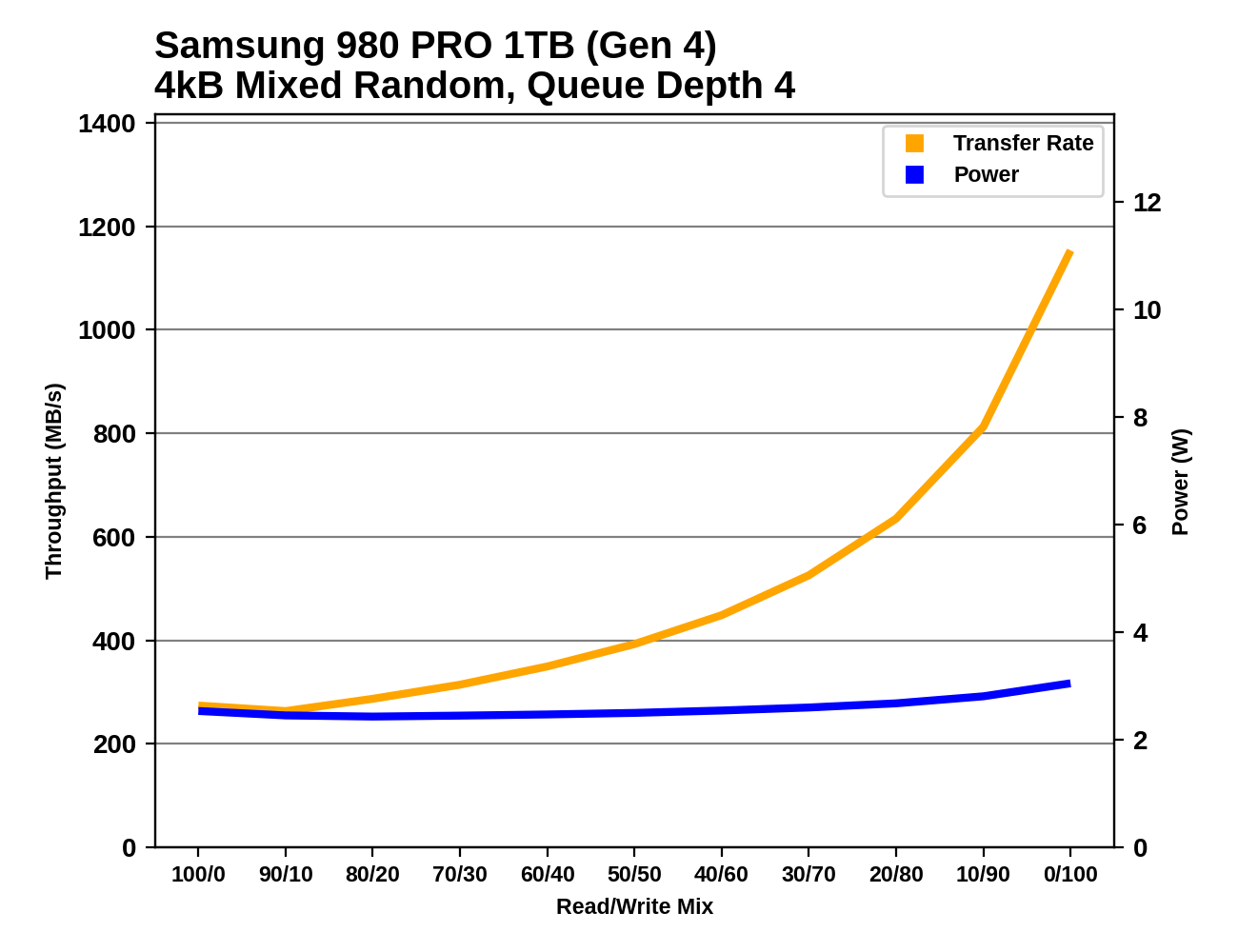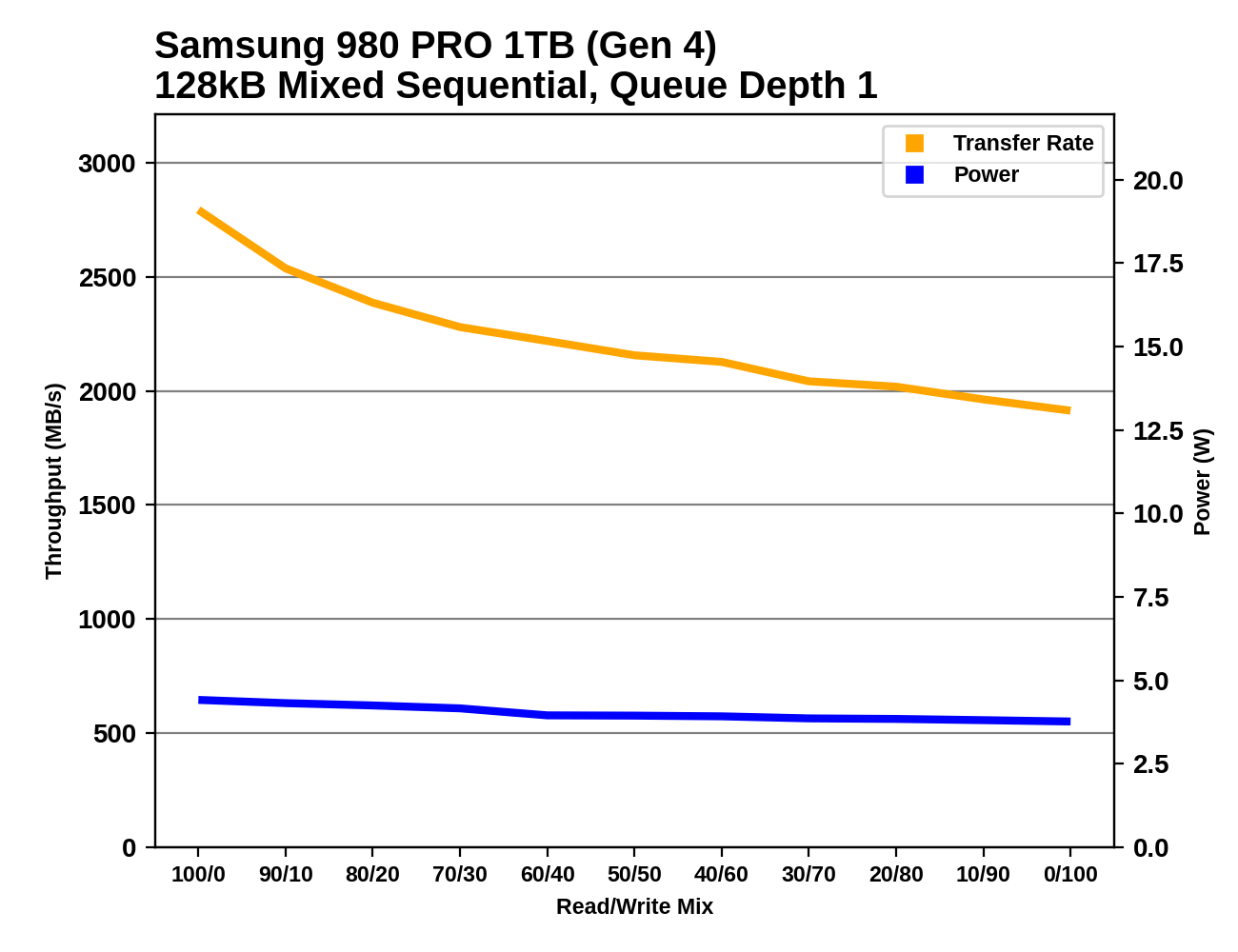The Samsung 980 PRO PCIe 4.0 SSD Review: A Spirit of Hope
by Billy Tallis on September 22, 2020 11:20 AM ESTNote: All our previous testing has been on an Intel test bed. Because of the move to PCIe 4.0, we have upgraded to Ryzen. Devices tested under Ryzen in time for this review are identified in the charts.
Mixed Random Performance
Our test of mixed random reads and writes covers mixes varying from pure reads to pure writes at 10% increments. Each mix is tested for up to 1 minute or 32GB of data transferred. The test is conducted with a queue depth of 4, and is limited to a 64GB span of the drive. In between each mix, the drive is given idle time of up to one minute so that the overall duty cycle is 50%.

Since our mixed random IO test uses a moderate queue depth of 4, the PCIe Gen4 drives don't get much chance to flex their muscle. The overall scores are still generally bound by NAND flash latency, which doesn't vary too widely between current generation drives. There's also a small performance boost when running this test on our newer, faster Ryzen testbed. The Samsung 980 PRO is clearly an improvement over its predecessors, but is merely tied for first place among flash-based drives with the SK hynix Gold P31.
 |
|||||||||
| Power Efficiency in MB/s/W | Average Power in W | ||||||||
Both capacities of the 980 PRO turn in good efficiency scores for the mixed random IO test, substantially improving on Samsung's previously mediocre standing. The 1TB 980 PRO's efficiency is second only to the SK hynix Gold P31. The 980 PROs are a bit more efficient running at PCIe Gen3 speeds than on the Gen4 platform, despite the ~10% performance boost on the faster system.
 |
|||||||||
There are no real surprises in the performance profiles of the 980 PROs. Both capacities show the same general behavior as earlier Samsung drives, albeit with small improvements to performance and power consumption across the board.
Mixed Sequential Performance
Our test of mixed sequential reads and writes differs from the mixed random I/O test by performing 128kB sequential accesses rather than 4kB accesses at random locations, and the sequential test is conducted at queue depth 1. The range of mixes tested is the same, and the timing and limits on data transfers are also the same as above.

The Samsung 980 PROs take the top spots for our mixed sequential IO test, with even the 250GB 980 PRO edging out the 1TB Seagate FireCuda 520. Even when limited to PCIe Gen3, the 980s are a clear step up in performance from eariler high-end drives. The improvement for the 250GB model is the most impressive, since the 250GB 970 EVO Plus is significantly slower than most of the 1TB drives.
 |
|||||||||
| Power Efficiency in MB/s/W | Average Power in W | ||||||||
The 980 PROs turn in more good power efficiency numbers that place them clearly ahead of everything other than the SK hynix Gold P31. And this time, the P31's efficiency lead relatively small at no more than about 25%.
 |
|||||||||
The 980 PROs show a drastically different performance profile compared to earlier Samsung drives. The 970s tend to bottom out during the write-heavy half of the test and recover some performance toward the end. Now with the 980 PRO, performance in the write-heavy half doesn't drop precipitously, so we see a steady decline that most closely resembles how the Intel Optane SSD handles this test










137 Comments
View All Comments
Tomatotech - Wednesday, September 23, 2020 - link
Updating my comment - StorageReview tested the 980 Pro with enterprise workloads. It seems a fantastic performer there, with some of the highest numbers I’ve ever seen, especially in random 4K r/w, which is an area I’ve long felt nvme was neglecting. The 980 Pro is a drive that finally performs well in this area.That said, that performance requires a monster 128 queue depth which is fine in enterprise but is very rarely seen in desktop computing. Oh well, it’s called Pro for a reason. That aspect of its performance justifies the price in my view.
https://www.storagereview.com/review/samsung-980-p...
Someguyperson - Tuesday, September 22, 2020 - link
Why haven't you tested any Phison E16 drives yet? I get that power consumption was seen as an issue, but with these drives pulling 20 watts, I don't think Phison E16 drives would be all that different. That said, the only way to validate any of those claims is by actually testing the drives. Which you haven't done yet.Slash3 - Tuesday, September 22, 2020 - link
The Firecuda 520 is a Phison E16 design.londedoganet - Tuesday, September 22, 2020 - link
> Samsung Elpisouk élabon pólin; álla gàr elpìs éphē kaká
pogostick - Friday, October 2, 2020 - link
I have no idea what this says, but I know exactly what it says.Duncan Macdonald - Tuesday, September 22, 2020 - link
An extreme endurance drive (all SLC) would seem to be a useful niche product for some users. It should be possible to produce such a drive with just a software modification to the controller. Obviously the cost/GB would be much higher but for some uses the extra cost would be worth it.(The same amount of NAND that would provide 2TB in TLC mode would only provide around 600GB in SLC mode.)
Tomatotech - Tuesday, September 22, 2020 - link
You’re talking about enterprise SSDs. They’re over that way. And one was included in the testing in this very article you’re reading.FunBunny2 - Wednesday, September 23, 2020 - link
"(The same amount of NAND that would provide 2TB in TLC mode would only provide around 600GB in SLC mode.)"if memory serves, at least one of the AT SSD reviewers has pointed out that TLC/QLC NAND run in 'SLC mode' isn't actually SLC. and doesn't perform like it.
CheapSushi - Thursday, December 17, 2020 - link
Get OPTANE. Why do so many people constantly overlook Optane? Optane has even higher endurance than SLC.lilmoe - Tuesday, September 22, 2020 - link
With the move to 128l 8nm NAND, I was hoping for MLC with higher capacity, faster performance and lower prices at the same endurance level of the 970 Pro.But with TLC, this is still significantly more expensive than the EVO Plus, and not worth it for the average consumer considering the competition. It's just making Hynix Gold look that much better. This isn't what the Pro series customers wanted, Samsung...
Oh well, RIP Pro line... Really disappointed.